Research on the Multi-Period Small-Signal Stability Probability of a Power System with Wind Farms Based on the Markov Chain
Abstract
:1. Introduction
2. The Markov Chain
3. Uncertainty Modeling of Wind Power Based on the Markov Chain
3.1. The Markov Property of Wind Speed
3.2. The Establishment of Transition Matrix
- (1)
- The state division of wind speed: for single wind farm, random variables are the wind speeds for the wind farm, where wind speeds are divided into s discrete intervals. For multi wind farms, wind speeds of each wind farm are random variables. Considering the influence of geographical and environmental factors, wind speeds of each wind farm in the same area often have a certain correlation. Then we can combine the states of each wind farm’s wind speed and make use of the transition probability to reflect the correlation relationship. That is, the statistical transition probabilities obtained will be different if the correlations are different. Assume n wind farms, the number of wind speed states of which are s1, s2, …, sn respectively. Then the total number of the system’s states is
- (2)
- Historical wind speed data statistics: set the historical wind speed data as sample data, judge which state the sample data belongs to according to the state division of wind speed, calculate statistics of the number of times (Nij) that the wind speed’s state transfers from Xi to Xj in adjacent time, and obtain the transition frequency matrix:
- (3)
- The establishment of the transition matrix: according to the definition of transition probability we can get:Thus, the transition matrix P between each wind speed state is obtained.
- (4)
- The establishment of multi-step transition matrix: according to the definition of multi-step transition matrix, we can get the k-step transition matrix Pk after iterating matrix P for k times.
3.3. The Probability Distribution Model of Multi-period Wind Speed
3.4. The Probability Distribution Model of Multi-period Wind Power
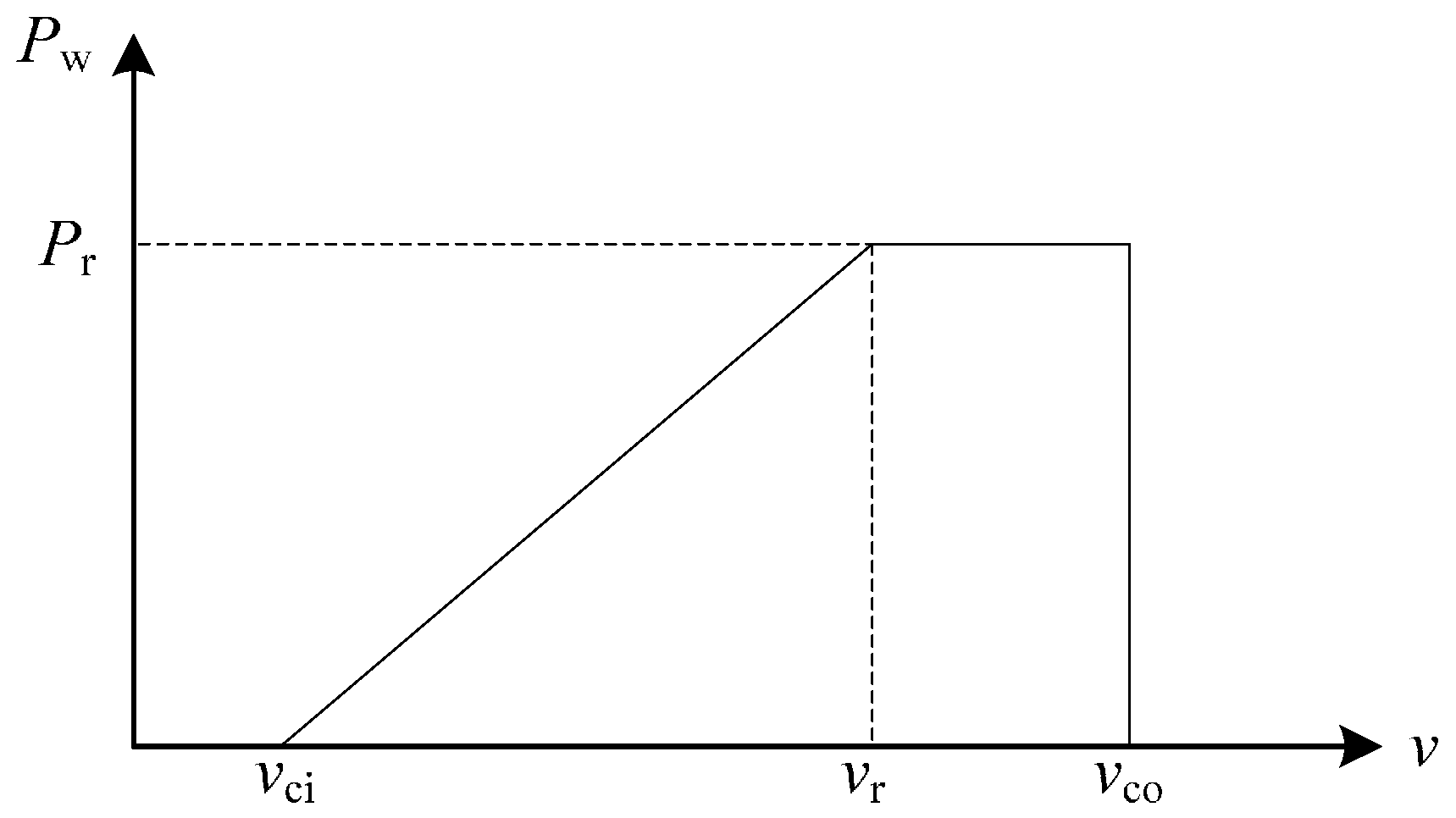
4. The Evaluation Model of Multi-Period Small-Signal Stability Probability of a Power System with Wind Farms
4.1. The Boundary-Based Small-Signal Stability Probability Evaluation Method
4.1.1. Small-signal Stability Region Boundary
4.1.2. The Model of Small-signal Stability Region Boundary
4.1.3. Evaluation Method
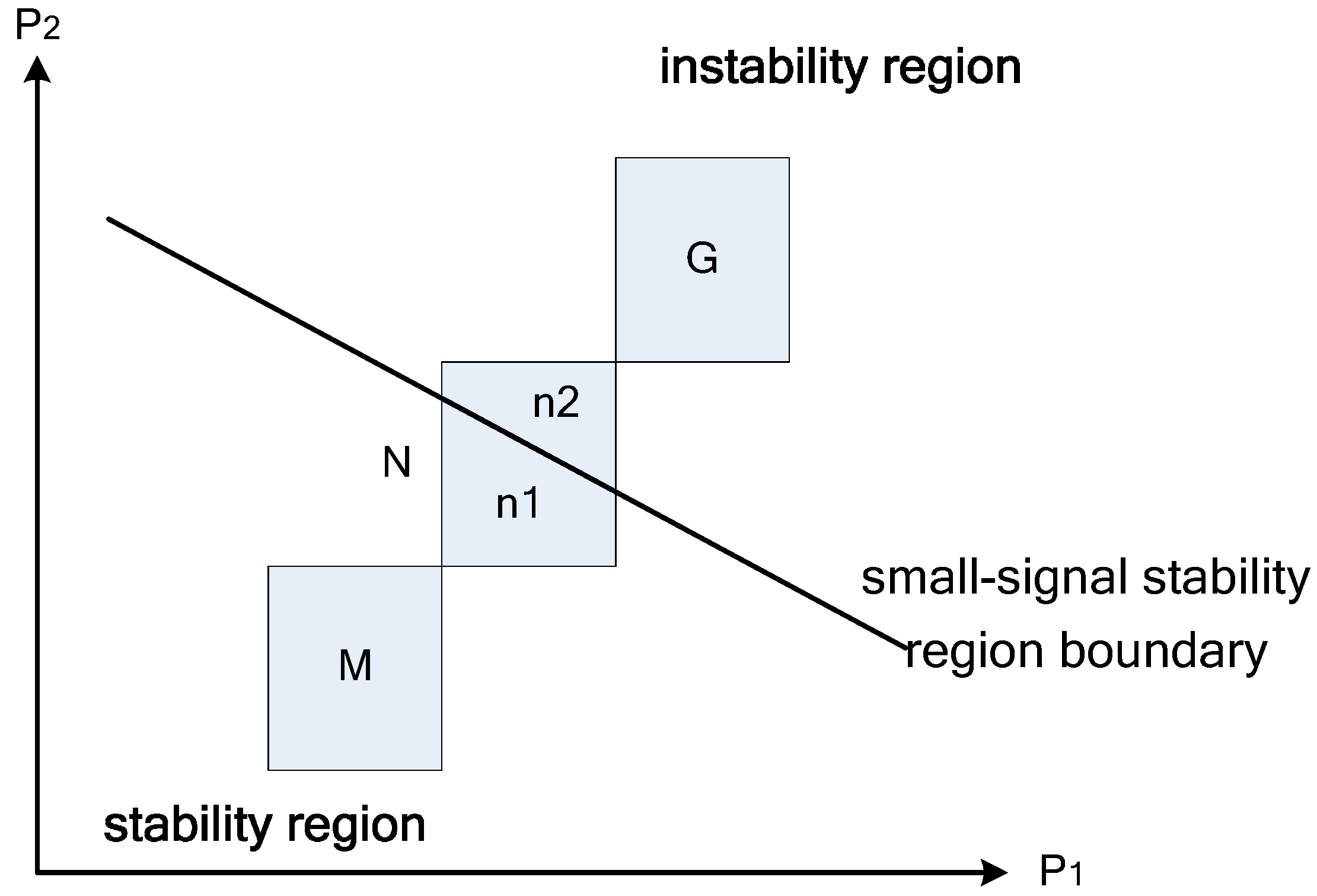
4.2. The Evaluation Model of Multi-period Small-signal Stability Probability of a Power System with Wind Farms Considering the Uncertainty of Wind Power

5. Example Analysis
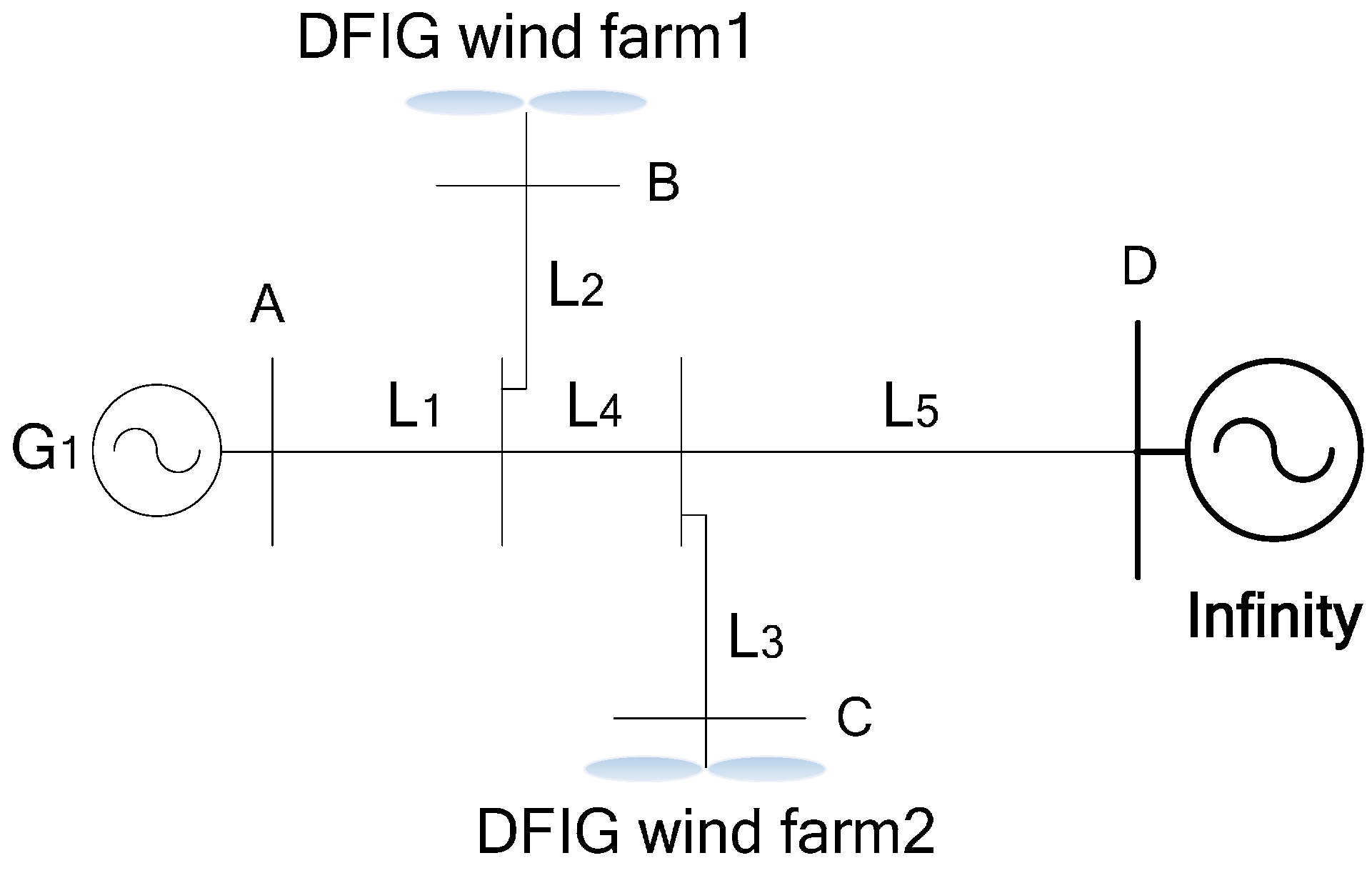
5.1. Calculation of Small-signal Stability Region Boundary of the Power System
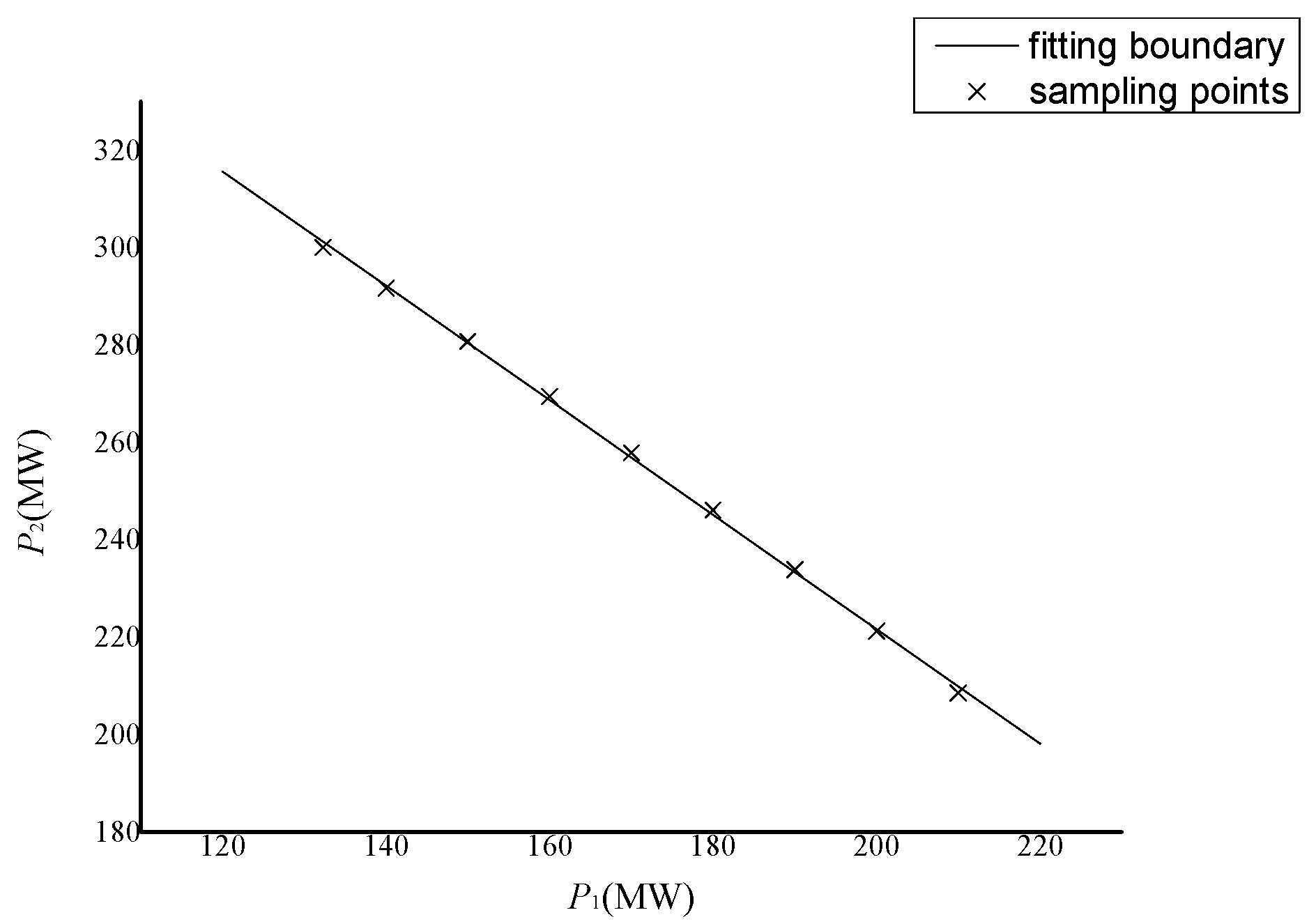
5.2. Analysis of Small-signal Stability Probability of the Power System Considering the Uncertainty of Wind Power
5.2.1. Calculation of the One-step TransitionMatrix
5.2.2. Analysis of the Influence of Wind Speed’s Initial States
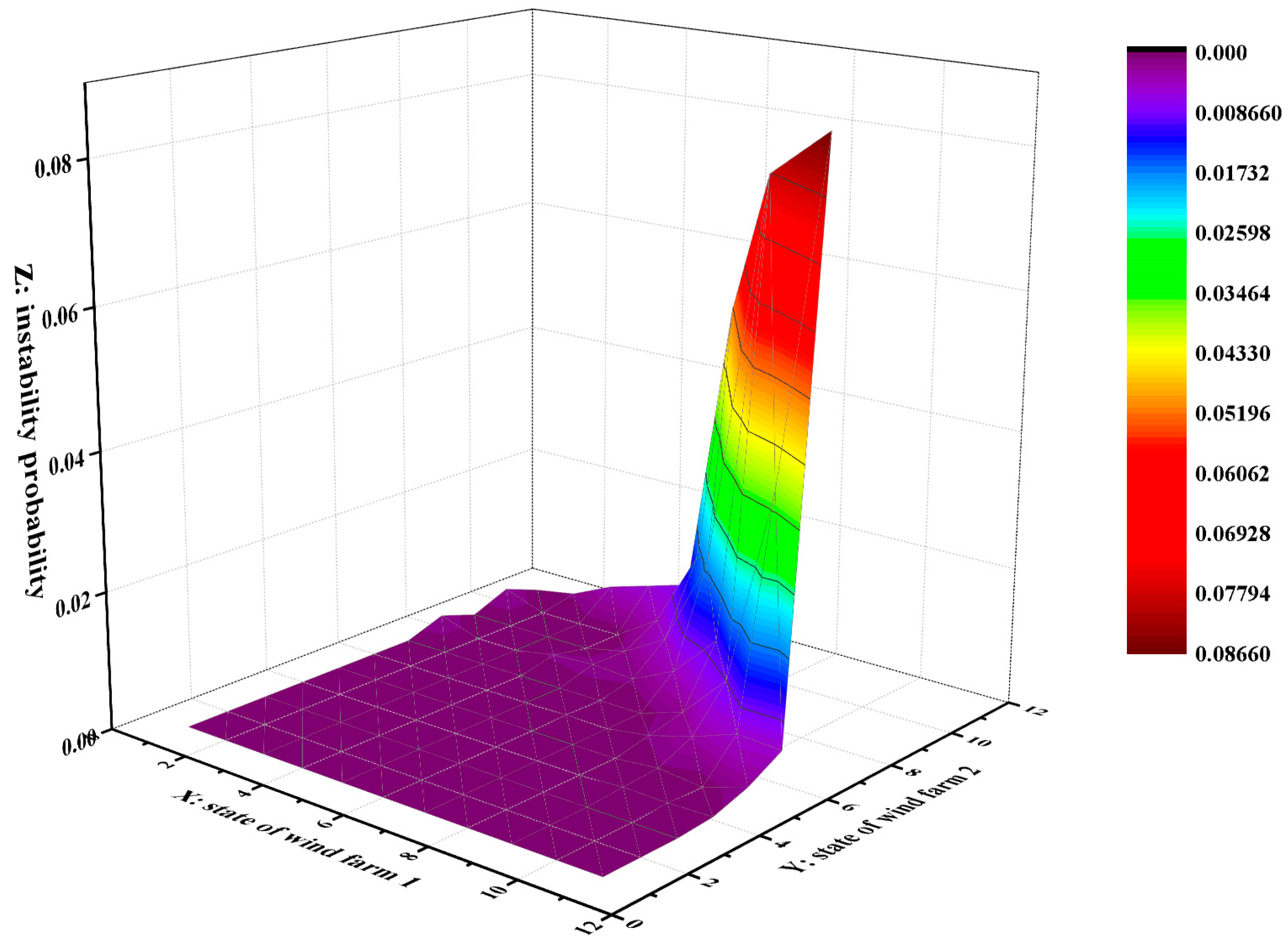
5.2.3. The Influence of Multi-time Periods
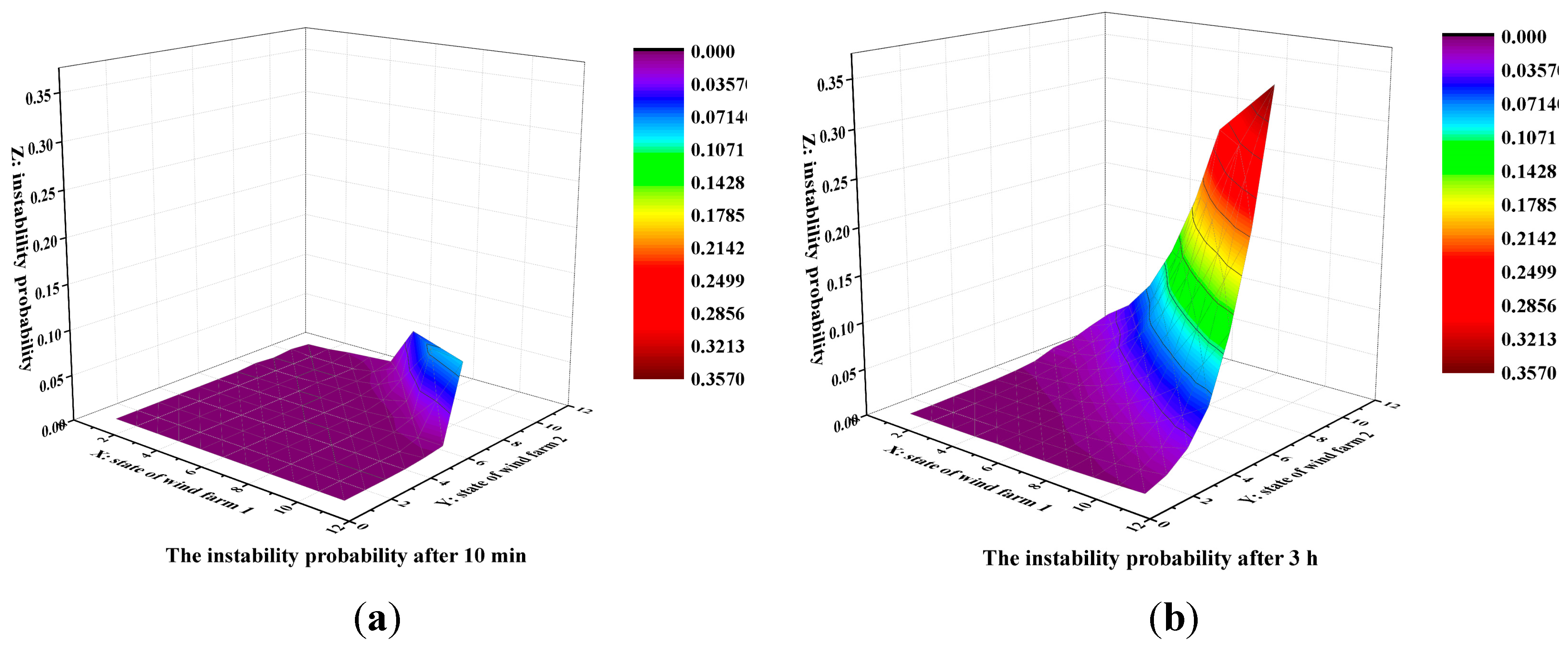
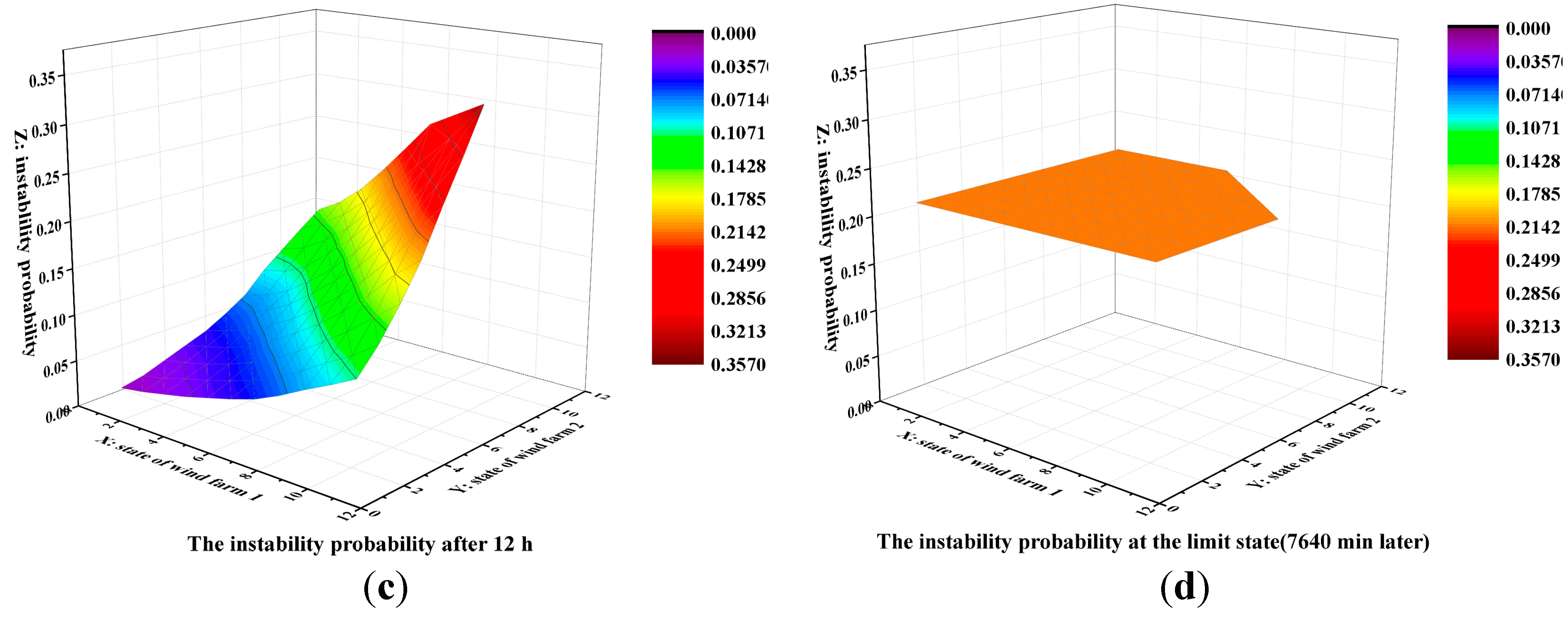
5.2.4. Discussion on the Simulation Results
- (1)
- When the period of time reaches 7640 min, the calculated results of stability are the results of the small-signal stability probability of the system by the traditional method based on a probability distribution of wind speed. That is, in a long period of time, the frequency distribution of wind speed has certain probability characteristics, so the system has a small-signal stability probability and the probability value is independent of the initial state of the wind speed and only has a correlation with the overall probability distribution of wind speed.
- (2)
- Similarly, the small-signal stability probability of the system at the limit state or by the traditional method actually reflects the stability characteristics of the system on a considerable long time scale. However, on short time scales, the traditional method is not applicable to the change of the small-signal stability characteristics of the system caused by the change of wind speed.
- (3)
- On short time scales, the initial state of the system has great influence on the further stability characteristics. The steady operation point of the wind farm should be kept away from the small-signal stability region boundary.
6. Conclusions
- (1)
- On short time scales, the instability probability of the system has strong correlation with the current state. When the initial state is far from the boundary, the probability that the system loses stability at the next moment is very small. While when the initial state of the system is closer to the boundary of the stability region boundary, the instability probability of the system at the next moment is greater.
- (2)
- In the case that the initial state is far from the stability region boundary, the probability that the system loses stability gradually increases with the increase of the period of time. While in the case that the initial state is close to the stability region boundary, the probability that the system loses stability first increases quickly and gradually decreases afterwards with the increase of the period of time. Finally, when the system reaches the limit state, no matter what the initial state is, the instability probabilities of the system will be exactly the same.
- (3)
- When the system reaches the limit state, the calculated stability probability is independent of the initial state, which is also the result of the small-signal stability probability of the system by the traditional method based on probability distribution of wind speed, which reflects the probability characteristics of the system on a considerable long time scale.
- (4)
- On short time scales, the initial state of the system has great influence on the further stability characteristics. The steady operation point of the wind farm should be kept away from the small-signal stability region boundary of the system.
Acknowledgments
Author Contributions
Appendix
Appendix A
Appendix A1 DFIG Parameters
Appendix A2 Generator Parameters
Appendix A3 Excitation parameters
Appendix A4 Line parameters
Appendix B
| P1(MW) | P2(MW) | Real part | Imaginary part | Error (%) |
|---|---|---|---|---|
| 210 | 208.54 | 0.00004 | 6.96983 | 0.295 |
| 200 | 221.32 | 0 | 6.958073 | 0.069 |
| 190 | 233.83 | 0.00003 | 6.93381 | 0.096 |
| 180 | 246.03 | 0.00006 | 6.902787 | 0.191 |
| 170 | 257.87 | 0 | 6.872842 | 0.207 |
| 160 | 269.39 | 0.00004 | 6.841304 | 0.157 |
| 150 | 280.68 | 0.00002 | 6.698043 | 0.061 |
| 140 | 291.69 | 0.00003 | 6.750184 | 0.088 |
| 132.26 | 300 | 0.00003 | 6.713719 | 0.242 |
Conflicts of Interest
References
- Baños, R.; Manzano-Agugliaro, F.; Montoya, F.G.; Gil, C.; Alcayde, A.; Gómez, J. Optimization methods applied to renewable and sustainable energy: A review. Renew. Sustain. Energy Rev. 2011, 15, 1753–1766. [Google Scholar] [CrossRef]
- Hernandez-Escobedo, Q.; Saldana-Flores, R.; Rodriguez-García, E.R.; Manzano-Agugliaro, F. Wind energy resource in Northern Mexico. Renew. Sustain. Energy Rev. 2014, 32, 890–914. [Google Scholar] [CrossRef]
- Montoya, F.G.; Manzano-Agugliaro, F.; López-Márquez, S.; Hernández-Escobedo, Q.; Gil, C. Wind turbine selection for wind farm layout using multi-objective evolutionary algorithms. Expert Syst. Appl. 2014, 41, 6585–6595. [Google Scholar] [CrossRef]
- Liu, W.Y.; Ge, R.D.; Li, H.Y.; Ge, J.B. Impact of Large-Scale Wind Power Integration on Small Signal Stability Based on Stability Region Boundary. Sustainability 2014, 6, 7921–7944. [Google Scholar] [CrossRef]
- Slootweg, J.G.; Kling, W.L. The impact of large scale wind power generation on power system oscillations. Electr. Power Syst. Res. 2003, 67, 9–20. [Google Scholar] [CrossRef]
- Gautam, D.; Vittal, V.; Harbour, T. Impact of Increased Penetration of DFIG-based Wind Turbine Generators on Transient and Small Signal Stability of Power Systems. IEEE Trans. Power Syst. 2009, 24, 1426–1434. [Google Scholar] [CrossRef]
- Rueda, J.L.; Colome, D.G. Probabilistic performance indexes for small signal stability enhancement in weak wind-hydro-thermal power systems. IET Gener. Transm. Distrib. 2009, 3, 733–747. [Google Scholar] [CrossRef]
- Rueda, J.L.; Erlich, I. Impacts of Large Scale Integration of Wind Power on Power System Small-signal Stability. In Proceedings of the 4th International Conference on Electric Utility Deregulation and Restructuring and Power Technologies (DRPT), Weihai, Shandong, China, 6–9 July 2011.
- Bu, S.Q.; Du, W.; Wang, H.F.; Chen, Z.; Xiao, L.Y.; Li, H.F. Probabilistic analysis of small-signal stability of large-scale power systems as affected by penetration of wind generation. IEEE Trans. Power Syst. 2012, 27, 762–770. [Google Scholar] [CrossRef]
- Soleimanpour, N.; Mohammadi, M. Probabilistic small signal stability analysis considering wind energy. In Proceedings of the 2nd Iranian Conference on Smart Grids (ICSG), Tehran, Iran, 23–24 May 2012.
- Yue, H.; Li, G.Y.; Zhou, M. A Probabilistic Approach to Small Signal Stability Analysis of Power Systems with Correlated Wind Sources. J. Electr. Eng. Technol. 2013, 8, 1605–1614. [Google Scholar] [CrossRef]
- Carta, J.A.; Ramírezb, P.; Velázquez, S. A review of wind speed probability distributions used in wind energy analysis: Case studies in the Canary Islands. Renew. Sustain. Energy Rev. 2009, 13, 933–955. [Google Scholar] [CrossRef]
- Halilcevic, S.S.; Gubina, F.; Gubina, A.F. Prediction of power system security levels. IEEE Trans. Power Syst. 2009, 24, 368–377. [Google Scholar] [CrossRef]
- Li, J.; Wei, W. Probabilistic evaluation of available power of a renewable generation system consisting of wind turbines and storage batteries: A Markov chain method. J. Renew Sustain. Energy 2014, 6, 130–139. [Google Scholar]
- Wang, J.M.; Kang, J.J.; Sun, Y.F.; Liu, D.M. Load forecasting based on GM-Markov chain model. In Proceedings of the Second Pacific-Asia Conference on Circuits, Communications and System (PACCS 2010), Beijing, China, 1–2 August 2010.
- Li, Y.Z.; Niu, J.C.; Ru, L.; Yue, Y.T. Research of multi-power structure optimization for grid-connected photovoltaic system based on Markov decision-making model. In Proceedings of the International Conference on Electrical Machines and Systems, Wuhan, China, 17–20 October; 2008. [Google Scholar]
- Lawler, G.P. Introduction to Stochastic Processes, 2nd ed.; Chapman & Hall: New York, NY, USA, 1995; pp. 7–49. [Google Scholar]
- Michael, M.; Eli, U. Probability and Computing: Randomized Algorithms and Probabilistic Analysis; Cambridge University Press: London, UK, 2005; pp. 153–182. [Google Scholar]
- Shamshad, A.; Bawadi, M.A.; Wan Hussin, W.M.A.; Majid, T.A.; Sanusi, S.A.M. First and second order Markov chain models for synthetic generation of wind speed time series. Energy 2005, 30, 693–708. [Google Scholar] [CrossRef]
- Castro Sayas, F.; Allan, R.N. Generation availability assessment of wind farms. IEE Proc. Gener. Transm. Distrib. 1996, 143, 507–518. [Google Scholar] [CrossRef]
- Nicola, B.N.; Ole, H.; Birgitte, B.; Poul, S. Model of a synthetic wind speed time series generator. Wind Energy 2008, 11, 193–209. [Google Scholar] [CrossRef]
- Hocaoglu, F.O.; Gerek, O.N.; Kurban, M. The effect of markov chain state size for synthetic wind speed generation. In Proceedings of the 10th International Conference on Probabilistic Methods Applied to Power Systems (PMAPS 2008), Rincon, Puerto Rico, 25–29 May 2008.
- Yu, D.Y.; Han, X.H.; Liang, J.; Song, S.G. Study on the Profiling of China’s Regional Wind Power Fluctuation Using GEOS-5 Data Assimilation System of National Aeronautics and Space Administration of America. Autom. Electr. Power Syst. 2011, 35, 77–81. (In Chinese) [Google Scholar]
- Canizares, C.A.; Mithulananthan, N.; Milano, F. Linear Performance Indices to Predict Oscillatory Stability Problems in Power Systems. IEEE Trans. Power Syst. 2004, 19, 1104–1114. [Google Scholar] [CrossRef]
- Abed, E.H.; Varaiya, P.P.; Milano, F. Nonlinear Oscillations in Power Systems. Int. J. Elec. Power 1984, 6, 37–43. [Google Scholar] [CrossRef]
- Sun, Q.; Yu, Y.X. Hyper-Plane Approximation of Boundary of Small Signal Stability Region and Its Application. J. Tianjin Univ. 2008, 41, 647–652. (In Chinese) [Google Scholar]
- Yu, Y.X. Review of study on methodology of security regions of power system. J. Tianjin Univ. 2008, 41, 635–646. (In Chinese) [Google Scholar]
- Liu, W.Y.; Ge, R.D.; Lv, Q.C.; Li, H.Y.; Ge, J.B. Research on Small Signal Stability Region Boundary Model of the Interconnected Power System with Large-scale Wind Power. Energies 2015, 8, 2312–2316. [Google Scholar] [CrossRef]
- Fernández, L.M.; Jurado, F.; Saenz, J.R. Aggregated Dynamic Model for Wind Farms with Doubly Fed Induction Generator Wind Turbines. Renew. Energy 2008, 33, 129–140. [Google Scholar] [CrossRef]
- Ali, M.; Ilie, I.S.; Milanovic, J.V. Wind farm model aggregation using probabilistic clustering. IEEE Trans. Power Syst. 2008, 28, 309–316. [Google Scholar] [CrossRef]
- Hansen, A.D.; Jauch, C.; Sørensen, P.; Cutululis, N.; Jauch, C.; Blaabjerg, F. Dynamic Wind Turbine Models in Power System Simulation Tool DIgSILENT; The Risø National Laboratory: Roskilde, Denmark, 2003; pp. 1–82. [Google Scholar]
- National Renewable Energy Laboratory (NERL). Wind integration datasets. Available online: http://www.nrel.gov/wind/integratioiidatasets/ (accessed on 20 January 2014).
- Anderson, P.M.; Fouad, A.A. Power System Control and Stability, 2nd ed.; Wiley: West Sussex, UK, 2002; pp. 555–582. [Google Scholar]
© 2015 by the authors; licensee MDPI, Basel, Switzerland. This article is an open access article distributed under the terms and conditions of the Creative Commons Attribution license (http://creativecommons.org/licenses/by/4.0/).
Share and Cite
Ge, R.; Liu, W.; Li, H.; Zhuo, J.; Wang, W. Research on the Multi-Period Small-Signal Stability Probability of a Power System with Wind Farms Based on the Markov Chain. Sustainability 2015, 7, 4582-4599. https://doi.org/10.3390/su7044582
Ge R, Liu W, Li H, Zhuo J, Wang W. Research on the Multi-Period Small-Signal Stability Probability of a Power System with Wind Farms Based on the Markov Chain. Sustainability. 2015; 7(4):4582-4599. https://doi.org/10.3390/su7044582
Chicago/Turabian StyleGe, Rundong, Wenying Liu, Huiyong Li, Jianzong Zhuo, and Weizhou Wang. 2015. "Research on the Multi-Period Small-Signal Stability Probability of a Power System with Wind Farms Based on the Markov Chain" Sustainability 7, no. 4: 4582-4599. https://doi.org/10.3390/su7044582
APA StyleGe, R., Liu, W., Li, H., Zhuo, J., & Wang, W. (2015). Research on the Multi-Period Small-Signal Stability Probability of a Power System with Wind Farms Based on the Markov Chain. Sustainability, 7(4), 4582-4599. https://doi.org/10.3390/su7044582





